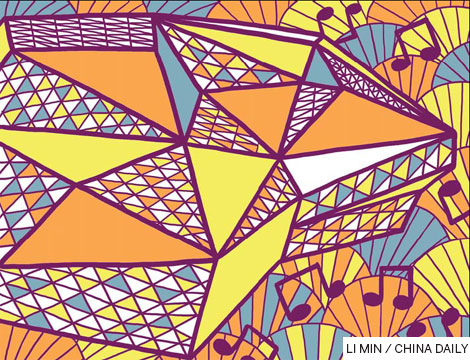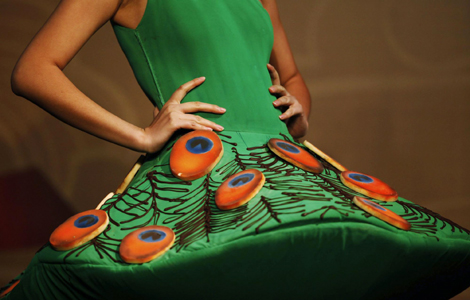Like a breath of fresh air
Updated: 2011-12-30 07:40
By Zaha Hadid (China Daily)
|
||||||||

China has made remarkable contribution to world architecture with its own original creations
Earlier this year, I traveled to Guangzhou to celebrate the completed Guangzhou Opera House design. It was heartwarming to know that the building has been well received within China and also internationally, with The New York Times describing it as "the most alluring opera house built anywhere in the world in decades". The Guardian newspaper (UK) in its report said "the world's most spectacular opera house has just opened in China".
This recognition is indeed an honor for me and my practice, but equally, for the people of Guangzhou.
To see such an ambitious artistic work become reality is the most rewarding of experiences and my gratitude to the city of Guangzhou is very deeply felt. It is always exciting to find such enthusiastic clients with great civic pride and passion for original artistic quality. These are vital characteristics that allow an architect to design extraordinary projects.
The Guangzhou Opera House design reflects China's long cultural history, and the remarkable future that China will play on a global stage.
I first traveled to China in 1981 at the very beginning of my career. My first impression was of the diversity and beauty of the landscapes. I visited many cities, from north to south, studying the art and architecture. I was intrigued with the way traditional Chinese painting layers space into infinity, giving us a sense of unexplored depth and boundless freedom; the way Chinese gardens manipulate and integrate intensive elements of nature; and the way the traditional architecture is embedded within the great theater of natural landscapes.
Each of these features has influenced my artistic career. Studying the country's traditional arts, architecture and garden design played an important role in the development of my creative work; and now, China has become one of the most exciting arenas for the realization of my architecture.
I am delighted to be continuing my work in China on seminal cultural, civic and commercial projects that equal the best in the world. We have worked extremely hard to ensure all these projects provide uplifting urban experiences. These designs demonstrate how the fluid language of architecture I have been developing throughout my career can enhance our everyday life by creating pleasant and stimulating environments for work, recreation and social life.
In every project, it is critical to include these important civic spaces that engage with the city. Last year, our design for the MAXXI: Italian National Museum of 21st Century Arts opened in Rome. The design is an urban cultural campus where a dense field of interior and exterior spaces are intertwined and superimposed over one another. Since the opening, one of the most exciting aspects of the MAXXI is the local community using the museum like a new Roman piazza. It is a place for people of all ages - like a village square - each afternoon and evening. The MAXXI is no longer just a museum; it has become an integral part of the urbanism of Rome itself.
Similarly, in Guangzhou, a series of higher and lower exterior terraces create multiple ground levels throughout the Opera House complex. These unique, inspirational exterior spaces are open to the public, and on my visit earlier this year, it was very rewarding to see how popular these public spaces have become with the people of Guangzhou.
Cities around the world must invest in these public spaces and cultural buildings. They are a vital component of a rich urban life and cityscape. Of course, we need good housing, transport, schools and workplaces as well, and by layering these different uses together, we are able to develop an architecture and urbanism that responds to the complexity of contemporary living. These cultural and civic projects unite the city - they tie the urban fabric together. An opera house, an arts center, a swimming pool or public park, by the very nature of their cultural and civic importance, these projects are accessible to everybody - which eliminates the segregation found in single-use developments.
I believe the complexities and dynamism of contemporary life cannot be cast into the simple orthogonal grids and blocks of the 20th Century architecture of Henry Ford's era. Therefore, one of the great challenges for contemporary urbanism and architecture is to move beyond the 20th century architecture of compartmentalization, toward a post-Fordist architecture for the 21st century: An architecture of flexible specialization that addresses complex work and life processes and the much greater fluidity in careers and corporate organizations.
Consequently, my work is operating with concepts, logic and methods that examine and organize the complexities of contemporary life patterns. The repetition and separation that defined buildings of the last century has been superceded by buildings that engage, integrate and adapt. These new systems allow the organization and planning of complex life processes that overlap and assimilate our life aspects of work, education, entertainment, habitation and transportation.
This approach to architecture and urbanism enables us to order and articulate complexity in ways that maintain legibility and orientation. Elements within the architecture fit together to form a continuum, creating an order, a logical, lawful differentiation of components that have the elegance of coherence. We often look at nature's systems when we create built environments; at her coherence and beauty.
By collaborating with engineers throughout China and working with advanced materials and construction methods, we are able to address very important issues in a meaningful way that help contribute to a more ecologically sustainable society.
In recent years, China has developed world-class cultural, civic and transportation projects that will serve its people well into the future. This ambition and commitment enables its cities to flourish.
I am very enthusiastic about China's contribution to world architecture, and hope to continue my involvement. China continues to energize me. Every time I come to China, I witness great new projects emerging. The dynamism of China's development is like a breath of fresh air for any architect.
I meet more and more Chinese architectural students at my university lectures around the world, and I employ more and more Chinese architects in my office in London; while many of my international staff are keen to work with our teams in China.
Each time I visit, I feel the enthusiasm, ambition and boundless energy of the upcoming generation of Chinese architects. Indeed, the new generation of Chinese architects seems to find some inspiration in my work. I suspect these architects sense my admiration for China's architectural traditions, or it is perhaps that my style demands a degree of commitment and optimism that one finds in places and periods where the young have embraced the future with confidence - yet not forgotten the past. China is such a place today.
I have been honored with the privilege of joining the jury for next year's Pritzker Prize. The prize is the most respected in world architecture with its award ceremony held in a different city each year. In 2004, I received the Pritzker Prize in St. Petersburg, Russia and I am absolutely delighted that next year's ceremony will be held for the first time in Beijing, one of the world's great capital cities - a fitting recognition of China's remarkable ambition and contribution to the global profession.
The author is a British architect and designer of the Guangzhou Opera House.











